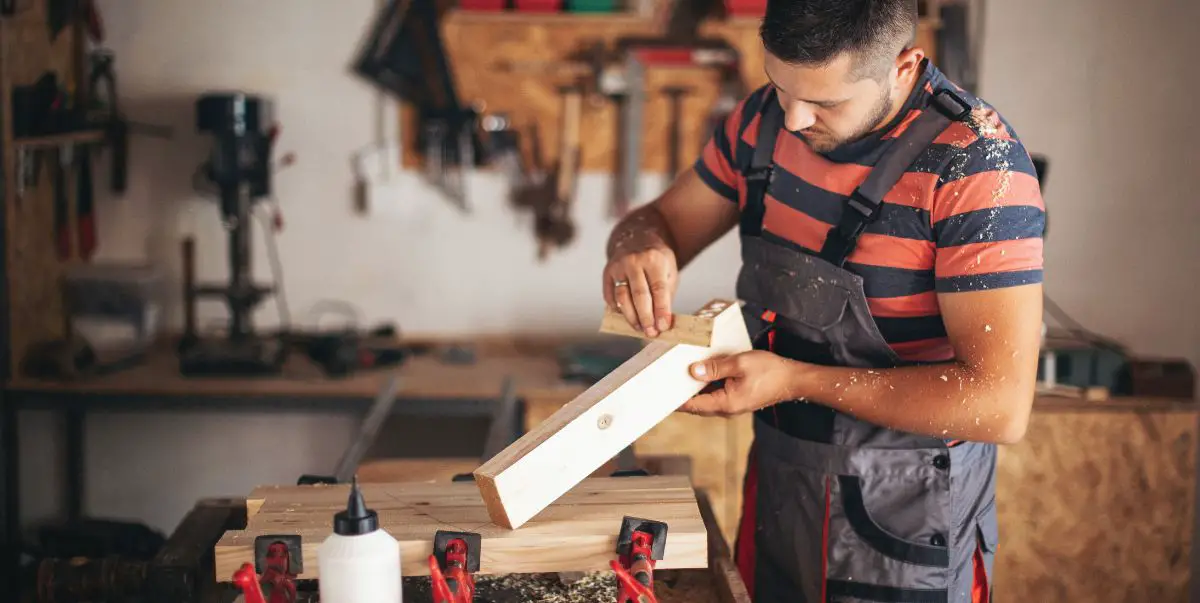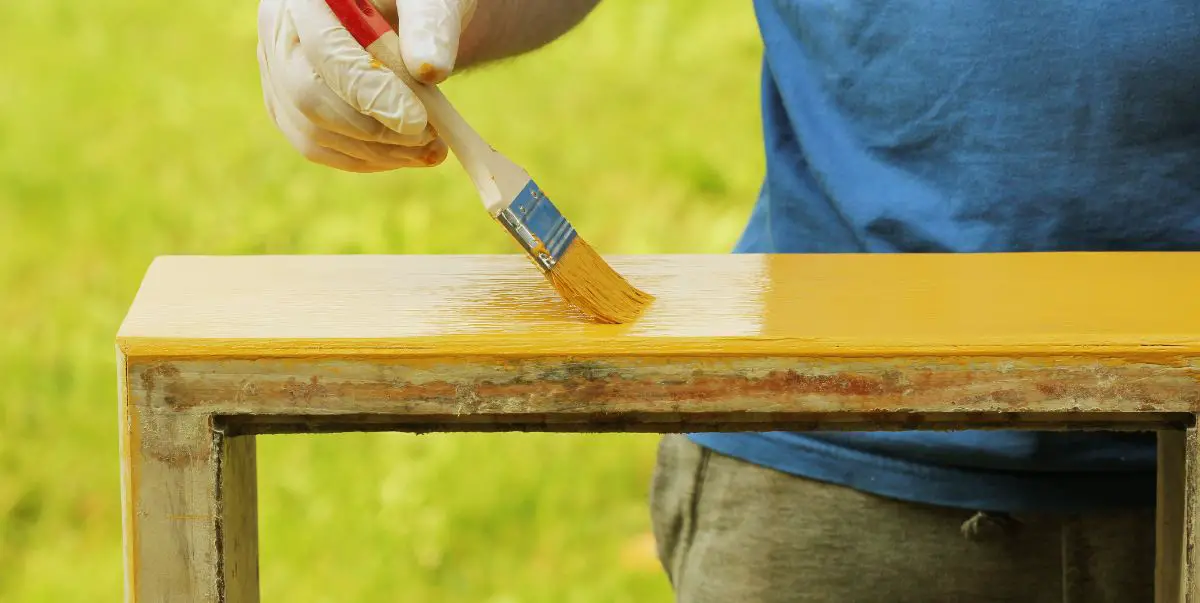Yes, wood glue can be used on painted wood surfaces without any issues. Introducing wood glue to painted wood can be a practical solution in various scenarios.
Whether you are repairing a wooden item with chipped or cracked paint or you want to attach two painted wood pieces together, wood glue offers a strong and reliable bond. However, it is crucial to prepare the painted surface properly by cleaning off any dust or debris.
This ensures better adhesion and prevents any potential issues with the bond. By choosing the right wood glue and following the appropriate steps, you can effectively use it on painted wood without any problems.
Exploring Wood Glue And Painted Wood
Wood glue is a commonly used adhesive for various woodworking projects. It is made up of a combination of polymers and resins that create a strong bond between wooden surfaces. The chemical composition of wood glue allows it to penetrate the porous fibers of the wood, creating a durable and long-lasting bond.
When it comes to using wood glue on painted wood, it’s important to consider the impact of the paint on the adhesive properties. Paint forms a protective layer on the surface of the wood, preventing the wood glue from effectively penetrating and bonding with the fibers. As a result, the adhesion strength of wood glue on painted wood may be compromised.
Moreover, the type of paint used can also affect the overall adhesion of the wood glue. Certain types of paint, such as oil-based or glossy finishes, can create a smooth and slippery surface that makes it difficult for the wood glue to adhere properly. On the other hand, matte or flat paints may offer a slightly better surface for wood glue adhesion.
| Impact of Paint on Wood Glue Adhesion |
|---|
| Porous paints like latex are better for wood glue adhesion. |
| Glossy or oil-based paints can reduce the adhesion strength. |
Nevertheless, it is important to note that even with the best conditions, the bond strength between wood glue and painted wood may not be as strong as bare wood. The presence of paint can act as a barrier, preventing the wood glue from fully contacting the wood fibers and creating a strong grip.
In conclusion, while it is possible to use wood glue on painted wood, it is important to consider the impact of the paint on the adhesion strength. If you are looking for a strong and durable bond, it is recommended to use wood glue on bare wood surfaces for optimal results.

Factors Affecting Wood Glue Adhesion On Painted Wood
When it comes to bonding painted wood with wood glue, there are several factors that can affect the adhesion of the glue. Understanding these factors is crucial for a successful and durable bond. Let’s explore the key factors that you need to consider:
Type Of Paint Used
The type of paint used on the wood surface plays a significant role in determining the ability of the wood glue to adhere. Not all paints are created equal, and certain types may have properties that make them more or less compatible with wood glue.
When using wood glue on painted wood, it is important to consider whether the paint is oil-based or water-based. Oil-based paints typically have a glossy or enamel-like finish, which can create a barrier between the wood and the glue. In contrast, water-based paints are generally more porous and may offer better adhesion.
Additionally, consider the age of the paint. Freshly applied paint may not have fully cured, and its surface may still contain volatile compounds that can interfere with the bond. It is recommended to wait for the paint to cure completely before attempting to use wood glue.
Surface Preparation Of Painted Wood
The surface preparation of the painted wood is another crucial factor that affects wood glue adhesion. Before applying wood glue, it is important to ensure that the painted surface is clean, dry, and free from any contaminants that could hinder the bond.
Start by thoroughly cleaning the painted surface to remove any dirt, dust, or grease. A gentle wipe with a damp cloth or mild detergent can help remove surface contaminants. Once clean, make sure the surface is completely dry before proceeding.
If the painted surface has a glossy finish, it may be necessary to lightly sand or roughen the surface to improve the bond. This can be done using fine-grit sandpaper, making sure to remove any loose paint particles and create a slightly textured surface for better adhesion.
Finally, consider using a primer specifically designed for paint adhesion. Primers can help improve the bond by providing a suitable surface for the wood glue to adhere to.
Using Wood Glue On Painted Wood: Best Practices
When it comes to wielding the power of wood glue on painted wood, it’s essential to follow best practices for a successful and durable bond. From choosing the right type of wood glue to employing effective application techniques, utilizing wood glue on painted wood requires attention to detail and precision. Let’s delve into these best practices to ensure a strong and lasting bond when working with painted wood.
Choosing The Right Type Of Wood Glue
When considering using wood glue on painted wood, it’s crucial to select the appropriate type of wood glue for the job. Different wood glues are designed for specific applications, such as interior or exterior use, and varying wood types. For painted wood projects, opt for polyvinyl acetate (PVA) wood glue as it provides excellent adhesion to painted surfaces and is suitable for a variety of woodworking projects. Always ensure the wood glue is compatible with painted surfaces and follows the manufacturer’s guidelines.
Effective Application Techniques
Applying wood glue to painted wood requires precision and attention to detail to achieve a durable and seamless bond. Before applying the wood glue, thoroughly prepare the painted wood surface by cleaning it to remove any dirt, dust, or debris. Apply the wood glue evenly, using a brush or spreader to ensure full coverage on the mating surfaces. After assembly, apply appropriate pressure to the joint, following the wood glue manufacturer’s instructions for clamping time and pressure. Allow adequate drying time before subjecting the bonded surfaces to stress or load to ensure a strong and lasting bond.
Potential Alternatives To Wood Glue For Painted Wood
When it comes to working with painted wood, using wood glue may not always be the best or most suitable option. Fortunately, there are several alternative options that you can consider for bonding painted wood effectively. In this article, we will explore two common alternatives: epoxy and polyurethane adhesives, as well as mechanical fastening methods.
Consideration Of Epoxy And Polyurethane Adhesives
Epoxy and polyurethane adhesives are two options worth exploring when it comes to bonding painted wood. These adhesives offer excellent bonding strength and durability, making them suitable for various applications.
Epoxy adhesive is known for its ability to create strong bonds in a wide range of materials, including painted wood. Its strong bond ensures that the painted wood pieces stay firmly in place. Similarly, polyurethane adhesive is also suitable for painted wood, as it forms a strong and flexible bond that can withstand different environmental conditions, making it ideal for both indoor and outdoor projects.
To use epoxy or polyurethane adhesives on painted wood:
- Prepare the surfaces by ensuring they are clean and free from any debris or dust particles.
- Apply the adhesive evenly onto one surface using a brush or applicator.
- Press the two painted wood pieces together firmly.
- Allow the adhesive to fully cure according to the product instructions before moving or applying any stress to the bond.
Exploring Mechanical Fastening Methods
If you prefer a more traditional approach or want additional reinforcement for your painted wood project, mechanical fastening methods can be a viable alternative to wood glue. These methods involve using screws, nails, or other hardware to secure the painted wood pieces together.
Before opting for mechanical fastening methods, there are a few factors to consider:
- Appearance: Mechanical fasteners may leave visible marks on the surface of the painted wood, which can affect the overall aesthetics of the project.
- Strength: While mechanical fastening methods provide strong bonds, they may not be as durable as adhesive bonds. The painted wood pieces may be prone to loosening over time, especially with frequent movement or exposure to external forces.
- Flexibility: Unlike glued joints, mechanical fastening methods offer less flexibility. If the project requires some degree of flexibility, adhesives might be a better option.
When using mechanical fasteners, it is essential to carefully select the appropriate size and type for your project. Ensure that the fasteners are driven securely and aligned properly to create a stable bond between the painted wood pieces.
Overall, while wood glue is commonly used for bonding painted wood, epoxy, and polyurethane adhesives, as well as mechanical fastening methods, offer alternative options that may better suit your specific project needs. By considering these alternatives, you can ensure a strong and reliable bond for your painted wood projects.
Real-life Applications And Case Studies
Yes, wood glue can be used on painted wood for various applications, including repairing furniture and craft projects. Using wood glue on painted wood provides a strong bond that can withstand everyday use. Real-life case studies have shown successful outcomes when using wood glue on painted wood for durable and long-lasting results.
Successful And Unsuccessful Scenarios
When it comes to using wood glue on painted wood, there are both successful and unsuccessful scenarios that can arise. Let’s take a look at some real-life applications and case studies to understand when wood glue can be used effectively on painted wood and when it may not be the best choice.
Successful Scenarios
In many cases, using wood glue on painted wood can be a successful and reliable solution. Here are a few scenarios where wood glue has been proven to work effectively:
- Repairing small cracks and chips: Wood glue can be used to repair small cracks and chips in painted wood surfaces. The glue creates a strong bond, ensuring the repair is long-lasting.
- Joining painted wood pieces: When you need to join two or more painted wood pieces together, wood glue can provide a secure and durable connection. It bonds the painted surfaces, creating a seamless and sturdy joint.
- Attaching small accessories: If you want to attach small accessories such as hooks, knobs, or brackets to a painted wood surface, wood glue can be a convenient option. It offers a strong hold without the need for drilling or screwing into the painted wood.
Unsuccessful Scenarios
While wood glue is generally reliable for various applications, there are some scenarios where it may not work as effectively on painted wood. These are some examples of unsuccessful scenarios:
- Peeling or flaking paint: If the painted wood surface has peeling or flaking paint, applying wood glue may not be the best solution. The glue needs a smooth and intact surface to create a strong bond.
- High-moisture environments: In high-moisture environments, such as bathrooms or outdoor spaces, using wood glue on painted wood may not be ideal. The moisture can weaken the bond, leading to potential failure.
- Heavy loads and stress: When it comes to heavy loads or stress on a painted wood joint, wood glue alone may not provide enough strength. In these cases, additional reinforcement, such as screws or nails, may be necessary.
Expert Recommendations And Tips
Based on real-life experiences and expert recommendations, here are some tips and recommendations to keep in mind when using wood glue on painted wood:
- Ensure the painted wood surfaces are clean and free from dirt, dust, or grease before applying the wood glue. This will help to provide a better bond.
- If possible, roughen the painted wood surface slightly with sandpaper before applying the wood glue. This will create a better surface for the glue to adhere to.
- Choose a high-quality wood glue that is suitable for the type of painted wood you are working with. Different wood glues have different characteristics and strengths.
- Allow enough drying and curing time for the wood glue to fully bond. Follow the manufacturer’s instructions for the specific wood glue you are using.
- If additional reinforcement is needed for strength, consider using screws, nails, or other appropriate fasteners in conjunction with the wood glue.

Frequently Asked Questions For Can You Use Wood Glue On Painted Wood
What Kind Of Glue Will Stick To Painted Wood?
Choose a glue specially designed for painted wood. It should bond effectively and withstand the surface’s finish, preventing any damage or peeling. Double-check the glue label to ensure it is compatible with painted surfaces.
Can You Glue Over the Paint?
Yes, you can glue over paint. Just make sure the paint is clean and dry before applying the glue.
Will Liquid Nails Work On Painted Wood?
Yes, liquid nails can work on painted wood surfaces. Ensure the paint is dry and clean for better adhesion.
Will Gorilla Wood Glue Stick To Paint?
Yes, Gorilla Wood Glue can stick to paint.
Conclusion
When using wood glue on painted wood, it’s important to consider the type of paint and the bonding capabilities of the glue. Take into account the specific conditions and surfaces involved. By understanding the potential challenges and choosing the right products, you can achieve strong, lasting results in your woodworking projects.


